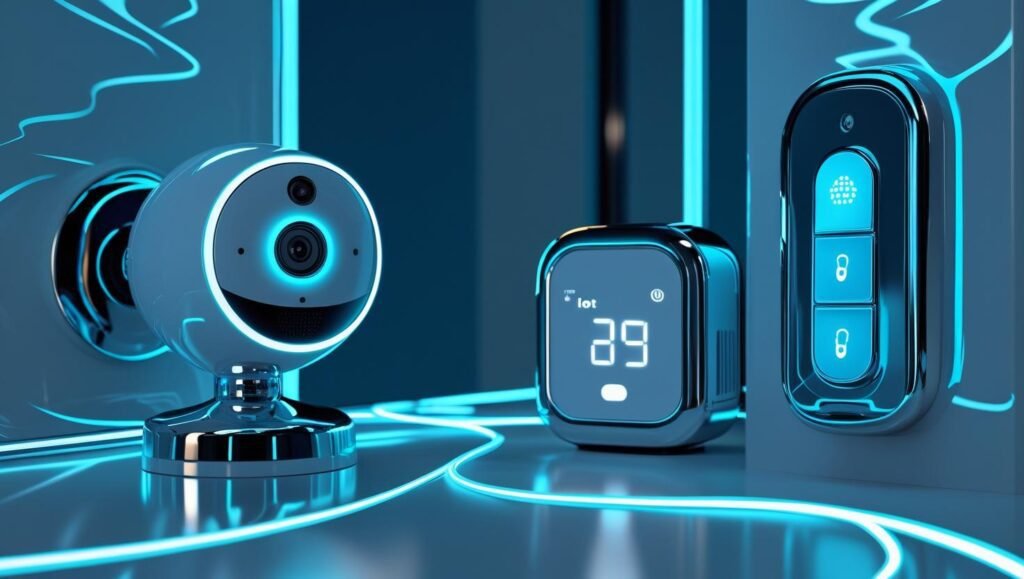IoT Security: Safeguard Your Devices from Threats

In today’s connected world, smart devices are everywhere. From doorbells that let you see who’s at the door to fridges that order groceries, the Internet of Things (IoT) makes life easier. But with convenience comes risk. IoT security is a big concern because hackers can target these devices to steal data or cause trouble. Let’s explore how you can keep your smart devices safe in a simple, stress-free way.
What Is IoT Security and Why Does It Matter?
IoT security means protecting your smart devices from cyber threats. These devices, like smart TVs, thermostats, or fitness trackers, connect to the internet, making them vulnerable to attacks. Hackers can exploit weak security to access your personal information or even control your devices.
Why should you care? Imagine someone hacking your smart camera to spy on your home. Or a hacker locking you out of your smart thermostat in winter. Strong IoT security stops these nightmares from happening. It keeps your data private and your devices working as they should.
Common IoT Threats You Should Know
Hackers use sneaky tricks to target IoT devices. Here are some common threats:
- Weak Passwords: Many devices come with default passwords like “admin” that hackers can easily guess.
- Outdated Software: Old firmware can have security holes that hackers exploit.
- Unsecured Networks: Public Wi-Fi or weak home networks can let hackers sneak in.
- Data Theft: Hackers can steal personal info, like your location or credit card details, from poorly secured devices.
Understanding these risks is the first step to better IoT security. Let’s look at how you can protect your devices.
Simple Steps to Boost Your IoT Security
You don’t need to be a tech expert to secure your smart devices. These easy steps can make a big difference in keeping hackers at bay.
1. Change Default Passwords Right Away
Every IoT device comes with a default password, but these are often weak and well-known to hackers. Change them as soon as you set up your device. Use a strong password with letters, numbers, and symbols, like “SunnyH1k3$2025”. Avoid using the same password for multiple devices to limit the damage if one gets hacked.
2. Update Your Devices Regularly
Manufacturers release updates to fix security flaws in your devices. Check for updates in the device’s app or settings at least once a month. Turn on automatic updates if possible to stay protected without the hassle. Keeping your firmware current is a key part of IoT security.
3. Secure Your Wi-Fi Network
Your home Wi-Fi is the gateway to your IoT devices. Make sure it’s locked tight:
- Use a strong Wi-Fi password (at least 12 characters).
- Enable WPA3 encryption (or WPA2 if WPA3 isn’t available).
- Hide your network name (SSID) to make it harder for hackers to find.
- Set up a separate guest network for visitors or less secure devices.
A secure network reduces the chance of hackers accessing your smart devices.
4. Use Two-Factor Authentication (2FA)
Two-factor authentication adds an extra layer of IoT security. It requires a second step, like a code sent to your phone, to log in. Many smart device apps, like those for cameras or door locks, now offer 2FA. Turn it on to make it harder for hackers to break in, even if they guess your password.
5. Limit Device Permissions
Some IoT devices ask for access to your location, microphone, or contacts. Only give permissions that the device needs to work. For example, a smart bulb doesn’t need to know your location. Check app settings to revoke unnecessary permissions and boost your privacy.

Advanced Tips for Extra IoT Security
If you want to go the extra mile, these tips can make your IoT devices even safer.
Monitor Your Network for Suspicious Activity
Use a network monitoring tool to keep an eye on your devices. Apps like Fing or router dashboards can show you what’s connected to your Wi-Fi. If you spot an unknown device, disconnect it immediately. Regular checks help you catch threats early.
Disable Features You Don’t Use
Many IoT devices have extra features, like remote access, that you might not need. Turn them off in the device settings to reduce the ways hackers can attack. For example, if you don’t control your thermostat remotely, disable its internet connection.
Consider a Separate IoT Network
For tech-savvy users, setting up a separate network for IoT devices is a smart move. This isolates your smart devices from your main network, where your phone or laptop lives. If a hacker compromises your smart speaker, they can’t easily jump to your computer. Most modern routers let you create a secondary network for this purpose.
Table: Quick IoT Security Checklist
| Action | Why It Helps |
|---|---|
| Change default passwords | Stops hackers from guessing easy passwords |
| Update firmware regularly | Fixes known security flaws |
| Secure Wi-Fi network | Blocks unauthorized access to devices |
| Enable 2FA | Adds an extra layer of login protection |
| Limit device permissions | Reduces data exposure |
This checklist makes it easy to stay on top of IoT security without feeling overwhelmed.
Mistakes to Avoid for Better IoT Security
Even with good intentions, some common mistakes can leave your devices vulnerable. Here’s what to watch out for:
- Ignoring Updates: Skipping firmware updates is like leaving your front door unlocked. Always install them promptly.
- Using Public Wi-Fi: Connecting IoT devices to public Wi-Fi is risky. Stick to secure, private networks.
- Buying Cheap, Unbranded Devices: Bargain IoT devices often lack proper security. Stick to trusted brands with a good track record.
- Not Reading Privacy Policies: Some devices collect more data than you’d expect. Check the privacy policy before buying.
Avoiding these pitfalls keeps your IoT security strong and your devices safe.
How to Choose Secure IoT Devices
Not all IoT devices are created equal. When shopping for new smart gadgets, look for these signs of good IoT security:
- Regular Updates: Choose brands that provide frequent firmware updates.
- Strong Encryption: Look for devices that use secure protocols like HTTPS or WPA3.
- Privacy Focus: Pick companies that are transparent about data collection.
- 2FA Support: Devices with two-factor authentication are a safer bet.
Researching before you buy can save you headaches down the road.
Conclusion: Stay Safe with Strong IoT Security
Securing your IoT devices doesn’t have to be complicated. By changing passwords, updating firmware, securing your Wi-Fi, and using 2FA, you can keep hackers at bay. Avoid common mistakes and choose devices from trusted brands to stay even safer. With these simple steps, you’ll enjoy the benefits of smart technology without the worry. Take control of your IoT security today and protect your home from hidden threats.
FAQs About IoT Security
Q: How often should I check for device updates?
A: Check at least once a month or enable automatic updates for convenience.
Q: Can hackers really spy through my smart camera?
A: Yes, if the camera isn’t secure. Use strong passwords, 2FA, and keep it updated.
Q: Is it worth setting up a separate IoT network?
A: If you have many devices, yes. It keeps your main network safer from attacks.




